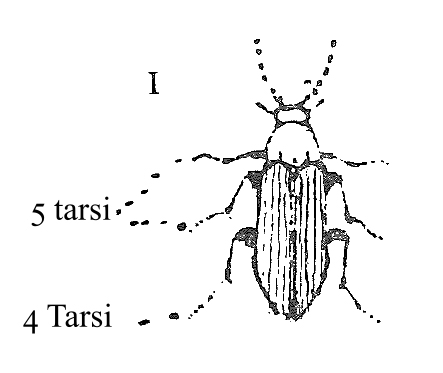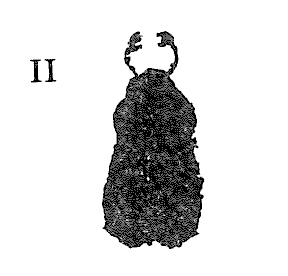To W. D. Fox1 12 [June 1828]
Friday 12th—2
My dear Fox
I am dying by inches, from not having any body to talk to about insects:—my only reason for writing, is to remove a heavy weight from my mind, so now you must understand, what you will perceive before you come to the end of this; that I am writing merely for my own pleasure & not your’s.— I have been very idle since I left Cambridge in every possible way & amongst the rest in Entomology. I have however captured a few insects, about which I am much interested: My sister has made rough drawings of three of them: I. fig: is I am nearly sure, the same insect as H⟨oa⟩r,3 of Queens took in a Willow tree, & which Garland4 did not know. I took [it] under the bark of a rail, was very active, striking looking insect, took 3 specimens I think this is an admirable prize
II. fig: is an extremely common insect; of the family of scarabidæ. Do you know it’s name?—
III. fig: A most beautiful Leptura (?) very like the Quadrifasciata, only the body is of the same size thoughout.— I tell you all these particulars, as I am anxious to know something about these little g⟨ ⟩s.— I was not fully aware of your extreme value before I left Cambridge. I am constantly saying “I do wish Fox was here”.— And I again say, I hope you will come & pay me visit before the summer is over— My Father desired me to say, that he should be at anytime most happy to see you.—
I have taken 3 species of Coccinellæ, one, the same as Hoar took in the Fens, which you said was rare, & another with 7 white! marks on each elytron.— I will mention, as I believe you are interested about it, that I have seen the Cocc: bipunctata (or dispar) 4 or 5 in actu coitus with a black one with 4 red marks (I believe most of the black ones you have got have ⟨ ⟩ marks, & hence I suppose a different species) also, which is very singular, I have frequently seen two of the bipunctata’s in actu.— I Have taken Clivina Collaris, fig ⟨3⟩ Plate III of Stephens;5 also a beautiful copper-coloured Elater (with Antennæ pectin⟨ate⟩
 like this. Do you want any of the Byrrhus Pillula? I can get any number.—
like this. Do you want any of the Byrrhus Pillula? I can get any number.—
My dear Fox I must again beg your pardon for sending such a very selfish stupid letter: but remember I am your pupil, so you must forgive me.— I hope you will write to me soon, & tell me every thing you have been doing, & more particularly how you are in health, as to your eyes, & body.— How was poor little Fan: how was No 16!? what do you intend doing this summer? in short write me a good long letter about yourself & all other insects: My plans remain the same as formerly. I am going to Barmouth6 for two months.— If you have not written to my brother, write to him before the 22d. & direct, Poste Restante, Munich I hope you will be able to send me a better account of Miss Fox, when you write; tell me whether you intend going to Tenby?
I should not send this very shamefully stupid letter, only I am very anxious to get some crumbs of information about yourself & the insects.
Believe me my dear Fox | Yours most sincerely | Charles Darwin
Shrewsbury
| of a fine bluish black colour, but is not so broad as made in this drawing | rather lighter coloured & more metallic the legs are left out.— | this is a very good representation |

|

|

|
I. fig is more like a Pyrochroa or a very narrow Blaps than any thing I can compare it to.—
I.I. fig: be sure to give me the name of this insect
Footnotes
Bibliography
LL: The life and letters of Charles Darwin, including an autobiographical chapter. Edited by Francis Darwin. 3 vols. London: John Murray. 1887–8.
Stephens, James Francis. 1828–46. Illustrations of British entomology; or, a synopsis of indigenous insects: containing their generic and specific distinctions. 11 vols. and supplement. London: Baldwin and Cradock.
Summary
Account of insects he has collected, with figures drawn by sister.
Letter details
- Letter no.
- DCP-LETT-42
- From
- Charles Robert Darwin
- To
- William Darwin Fox
- Sent from
- Shrewsbury
- Postmark
- Shrewsbury JU 13 1828 153
- Source of text
- Christ’s College Library, Cambridge (MS 53 Fox 1)
- Physical description
- ALS 4pp
Please cite as
Darwin Correspondence Project, “Letter no. 42,” accessed on 23 November 2024, https://www.darwinproject.ac.uk/letter/?docId=letters/DCP-LETT-42.xml
Also published in The Correspondence of Charles Darwin, vol. 1


